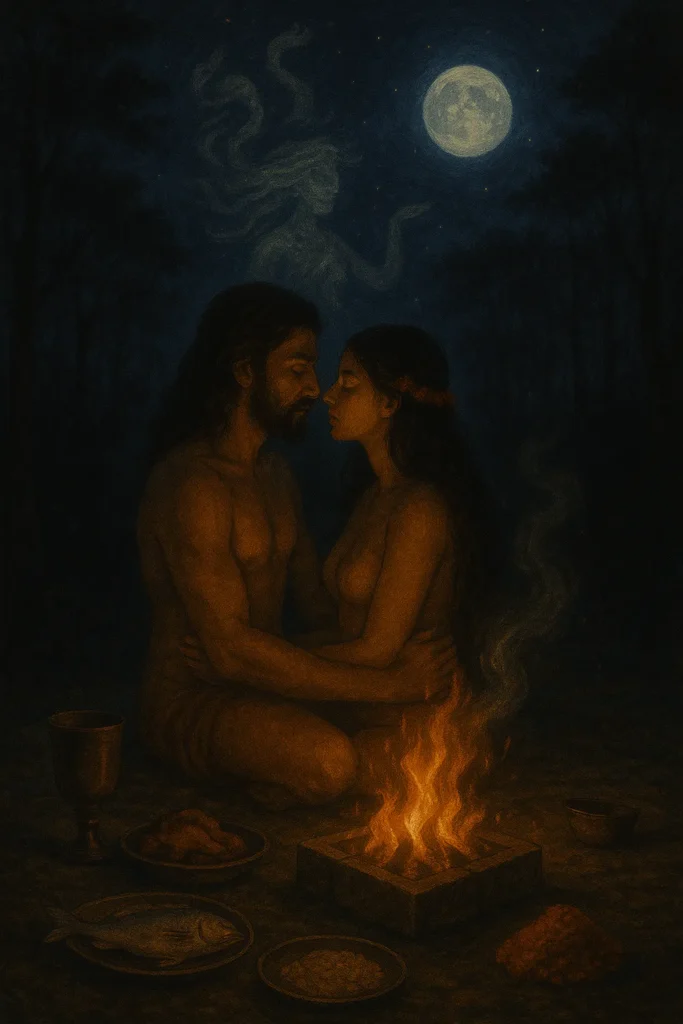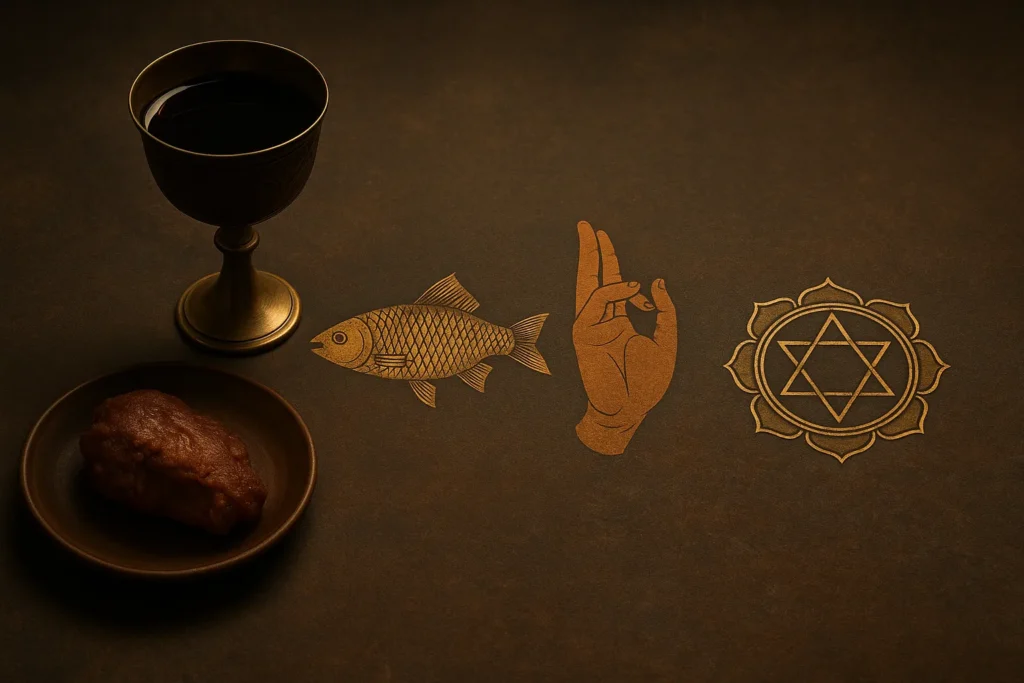The Hidden Language of Tantra
In the shadowed corners of ancient Indian spiritual traditions lies a misunderstood and often misrepresented path—Tantra. Among its most debated practices is the use of Panchamakara, or the “Five Ms”—Madya (wine), Māṃsa (meat), Matsya (fish), Mudrā (parched grain), and Maithuna (sexual union). These five elements form the heart of what is called Panchatattva, the fivefold truth. While modern minds often stumble at the literal implications, the esoteric reality of Panchamakara is far more symbolic, transformative, and spiritual than sensational.

Decoding the Panchamakara
Let us examine the Five Ms, each one a gateway to transcendence when understood not merely as physical items but as metaphysical symbols:
- Madya (Alcohol):
Represents the intoxication of divine bliss. It is not about losing control but about transcending the ordinary state of consciousness. In its highest form, madya is the ecstatic state achieved in deep meditation, where the boundary between self and divine dissolves. - Māṃsa (Meat):
Symbolizes the consumption of one’s own animalistic tendencies. It is not about cruelty or indulgence, but about the conquest of primal instincts. The Tantric adept “eats” his own limitations and transforms them into power. - Matsya (Fish):
Represents the dual nature of existence, gliding freely in the ocean of duality and unity. The fish signifies adaptability and awareness. It urges the sadhaka to swim through the emotional and mental depths without attachment. - Mudrā (Parched Grain or Gesture):
Denotes both a sacred gesture and the grain of spiritual sustenance. It is the symbol of offering, the seed of awareness offered to the divine within. It also stands for the control of the senses and pranic energy through yogic seals. - Maithuna (Sexual Union):
The most misinterpreted of all, maithuna is the union of Shiva and Shakti, the divine masculine and feminine. It is the merger of consciousness (Purusha) and energy (Prakriti), the alchemical explosion that leads to self-realization. In esoteric terms, it is not physical but kundalini awakening, a spiritual orgasm.
Left-Hand Path (Vāmācāra) vs. Right-Hand Path (Dakṣiṇācāra)
In Tantra, there is no absolute right or wrong—only the capacity of the practitioner. Thus, the left-hand path (vāmācāra) uses the Panchamakara literally—breaking social and moral taboos consciously to destroy ego and duality. This is done under strict guidance and is never for indulgence.
In contrast, the right-hand path (dakṣiṇācāra) interprets these elements symbolically. The practitioner visualizes or substitutes these items during internal worship or mental rituals (manasic puja), focusing entirely on the internal transformation.
Why the Panchamakara Matters
- Breaking Duality:
Panchamakara shocks the rigid mind and forces it to re-evaluate morality, moving from external rules to internal awareness. In doing so, it challenges the ego’s grip and opens the door to true non-duality (advaita). - Integration of Shadow Self:
Modern psychology speaks of the Shadow—the repressed part of the psyche. Panchamakara directly faces this shadow. Through conscious confrontation with the taboo, one integrates and transcends personal darkness. - Awakening the Kundalini:
Each M corresponds to a stage of kundalini awakening. For instance, madya loosens the grip of the rational mind, and maithuna ignites the sacred fire within. The practice serves as a ladder through which Shakti rises. - Deconditioning of the Mind:
Cultural norms often bind spiritual progress. Panchamakara deconditions the mind, preparing it for an unfiltered experience of the cosmos. It removes the concept of sin and piety and replaces it with consciousness and awareness. - Union of Shiva and Shakti:
The ultimate goal of Tantra is not liberation from the world but liberation in the world (jivanmukti). The five Ms symbolize the alchemical process of bringing the divine down into the body, into the now, and into love and life.
Panchamakara and the Modern Practitioner
In today’s world, literal use of Panchamakara may no longer be feasible or necessary for most seekers. However, its symbolic interpretation can be deeply enriching. Whether through meditative rituals, mantra recitation, visualization, or yogic practices, the principles behind Panchamakara are timeless.
In the realm of Kali worship, Shakta Tantra, and even some branches of Buddhist Tantra, the Five Ms are still used to awaken the Vira Bhava—the heroic attitude of the seeker who dares to transcend all limitations.
The Sacred Fire Behind the Taboo
To dismiss Panchamakara as mere hedonism is to miss its depth entirely. It is not about indulgence but about transcendence. It is the sacred path of those brave enough to look beyond appearances, who dare to stand naked before the truth of existence, unafraid, unashamed, and undivided.
The Five Ms are not just rituals—they are mirrors, showing the face of the divine hiding behind every form. When practiced with wisdom, humility, and the guidance of a true Guru, Panchamakara becomes not a fall from grace, but a direct flight into the heart of divinity.
“When the wine of bliss flows, when the fish of awareness swims, when the meat of ego is devoured, when the mudra seals the breath, and when Shiva embraces Shakti—then the Tantra begins.” – Acharya Sailyajit
Q1. What is Panchamakara in Tantra?
A: Panchamakara, also known as the “Five Ms,” refers to five sacred elements—Madya (wine), Māṃsa (meat), Matsya (fish), Mudrā (grain/gesture), and Maithuna (sexual union)—used in Tantric practice for spiritual transformation. These elements are symbolic tools for awakening higher consciousness.
Q2. Are the Five Ms in Tantra meant to be practiced literally?
A: In the left-hand path (Vāmācāra), they are practiced literally under strict spiritual guidance. In the right-hand path (Dakṣiṇācāra), they are interpreted symbolically, focusing on inner transformation through meditation and visualization.
Q3. Is Panchamakara about indulgence in forbidden acts?
A: No, it’s not about indulgence. Panchamakara is a spiritual discipline that confronts societal taboos to transcend duality, ego, and fear. It is practiced mindfully, with the aim of spiritual awakening—not pleasure.
Q4. What does Maithuna mean in Tantra?
A: Maithuna symbolizes the sacred union of Shiva (consciousness) and Shakti (energy). While it may involve ritual sexual union in some traditions, its deeper meaning lies in the inner alchemy of merging masculine and feminine energies within.
Q5. How is Panchamakara relevant in modern spiritual practice?
A: Today, most practitioners follow symbolic interpretations of the Five Ms. Through mantra, meditation, pranayama, and visualization, modern sadhakas can access the transformative power of Panchamakara without engaging in literal rituals.
Q6. Is Panchamakara connected to Kundalini awakening?
A: Yes. Each of the Five Ms is associated with stages of spiritual awakening and energy flow. For instance, Madya represents divine ecstasy, and Maithuna activates the inner union that triggers kundalini rise.
Q7. Can Panchamakara be practiced without a Guru?
A: It is strongly advised not to engage in literal practices without the guidance of a realized Guru. Symbolic practice, however, through proper study and self-discipline, can be explored with devotion and care.











